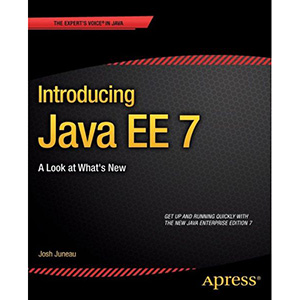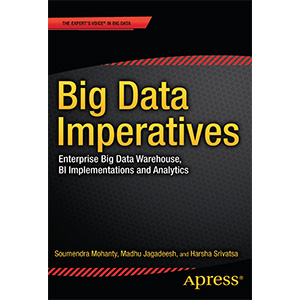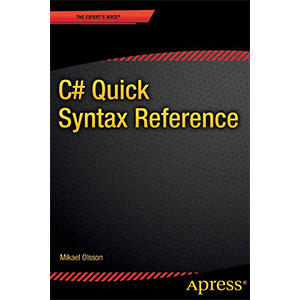| RMAN Recipes for Oracle Database 12c, 2nd Edition Posted: 14 Aug 2013 10:55 AM PDT 
Book Description RMAN Recipes for Oracle Database 12c is an example-driven approach to the Oracle database administrator’s #1 job responsibility: - Be able to recover the database.
Of all the things you are responsible for as database administrator, nothing is more important than the data itself. Like it or not, the fearsome responsibility of protecting your organization’s most critical data falls squarely upon your shoulders: - Lose that data and your company could fail.
- Lose that data and you could be out of a job.
Oracle’s flagship database product fortunately implements a wide-ranging feature set to aid you in the all-important task of safeguarding against data loss. Recovery Manager, or RMAN, is at the heart of that feature set, and is the tool most-often used to initiate database backup and recovery operations. In this book, well-known authors and database experts Darl Kuhn, Sam Alapati, and Arup Nanda have created a set of examples encompassing the gamut of backup and recovery tasks that you might need to perform. Sometimes, especially when the heat is on, a good example is what you need to get started towards a solution. RMAN Recipes for Oracle Database 12c delivers. It'll be the book you reach for when that dreaded call comes in at 3:00am some dreary morning. It'll be the book that lets you sleep at night knowing that no matter what transpires, that you’ve done your job well and can recover from any outage. RMAN Recipes for Oracle Database 12c gets right to the point with quick and easy-to-read, step-by-step solutions that can help you backup and recover your data with confidence. What you'll learn - Reliably back up and recover your database using Oracle’s Recovery Manager
- Let Oracle Database manage your backup files via the Fast Recovery Area
- Automate backup and recovery tasks by writing scripts
- Troubleshoot RMAN problems and optimize RMAN performance
- Recover from the loss of a control file, loss of an online redo log, and from other unusual situations
Who this book is for
RMAN Recipes for Oracle Database 12c is aimed squarely at Oracle database administrators responsible for database backup and recovery operations. Table of Contents
Chapter 1. Backup and Recovery 101
Chapter 2. Jump-Starting RMAN
Chapter 3. Using the Fast Recovery Area
Chapter 4. Using RMAN
Chapter 5. Configuring the Rman Environment
Chapter 6. Using the Recovery Catalog
Chapter 7. Making Backups with RMAN
Chapter 8. Maintaining RMAN Backups and the Repository
Chapter 9. Scripting RMAN
Chapter 10. Restoring the Control File
Chapter 11. Performing Complete Recovery
Chapter 12. Performing Incomplete Recovery
Chapter 13. Performing Flashback Recovery
Chapter 14. Handling Online Redo Log Failures
Chapter 15. Duplicating Databases and Transporting Data
Chapter 16. Tuning RMAN
Chapter 17. Troubleshooting RMAN
Chapter 18. Using Oracle Secure Backup as a Media Management Layer
Chapter 19. Performing Backup and Recovery with Enterprise Manager
Chapter 20. Using the Data Recovery Advisor
Chapter 21. Using RMAN on Windows
Chapter 22. RMAN in an Oracle Data Guard Environment
Chapter 23. RMAN and RAC
Chapter 24. RMAN and ASM
Chapter 25. RMAN in Exadata Book Details - Paperback: 796 pages
- Publisher: Apress; 2nd Edition (July 2013)
- Language: English
- ISBN-10: 143024836X
- ISBN-13: 978-1430248361
Note: There is a file embedded within this post, please visit this post to download the file. Related Books The post RMAN Recipes for Oracle Database 12c, 2nd Edition appeared first on Wow! eBook. |
| Pro Oracle Database 12c Administration, 2nd Edition Posted: 14 Aug 2013 10:52 AM PDT 
Book Description Pro Oracle Database 12c Administration is a book focused on results. Author Darl Kuhn draws from a well of experience over a decade deep to lay out real-world techniques that lead to success as an Oracle Database administrator. He gives clear explanations on how to perform critical tasks. He weaves in theory where necessary without bogging you down in unneeded detail. He is not afraid to take a stand on how things should be done. He won't leave you adrift in a sea of choices, showing you three ways to do something and then walking away. Database administration isn't about passing a certified exam, or about pointing-and-clicking your way through a crisis. Database administration is about applying the right solution at the right time, about avoiding risk, about making robust choices that get you home each night in time for dinner with your family. If you have "buck stops here" responsibility for an Oracle database, then Pro Oracle Database 12c Administration is the book you need to help elevate yourself to the level of Professional Oracle Database Administrator. - Covers multi-tenant container and pluggable database implementation and management
- Condenses and organizes the core job of a database administrator into one volume.
- Takes a results-oriented approach to getting things done.
- Lays a foundation upon which to build a senior level of expertise
What you'll learn - Create a stable environment consistent across all databases that you manage
- Manage pluggable and multi-tenant databases
- Take care of job #1: backing up, and then recovering when needed
- Manage users and objects, and the security between them
- Do battle with "large"—large databases and large objects
- Move and distribute data using Data Pump, materialized views, external tables
- Automate critical jobs and tackle database troubleshooting problems
Who this book is for
Pro Oracle Database 12c Administration is aimed at new database administrators who aspire to senior positions in which employers and customers trust you to work independently, and with a "buck stops here" attitude. Table of Contents
Chapter 1. Installing the Oracle Binaries
Chapter 2. Implementing a Database
Chapter 3. Configuring an Efficient Environment
Chapter 4. Tablespaces and Data Files
Chapter 5. Managing Control Files, Online Redo Logs, and Archiving
Chapter 6. Users and Basic Security
Chapter 7. Tables and Constraints
Chapter 8. Indexes
Chapter 9. Views, Synonyms, and Sequences
Chapter 10. Data Dictionary Fundamentals
Chapter 11. Large Objects
Chapter 12. Partitioning: Divide and Conquer
Chapter 13. Data Pump
Chapter 14. External Tables
Chapter 15. Materialized Views
Chapter 16. User-Managed Backup and Recovery
Chapter 17. Configuring RMAN
Chapter 18. RMAN Backups and Reporting
Chapter 19. RMAN Restore and Recovery
Chapter 20. Oracle Secure Backup
Chapter 21. Automating Jobs
Chapter 22. Database Troubleshooting
Chapter 23. Pluggable Databases Book Details - Paperback: 756 pages
- Publisher: Apress; 2nd Edition (July 2013)
- Language: English
- ISBN-10: 1430257288
- ISBN-13: 978-1430257288
Note: There is a file embedded within this post, please visit this post to download the file. Related Books The post Pro Oracle Database 12c Administration, 2nd Edition appeared first on Wow! eBook. |
| Introducing Java EE 7 Posted: 14 Aug 2013 10:48 AM PDT 
Book Description Introducing Java EE 7: A Look at What's New guides you through the new features and enhancements in each of the technologies comprising the Java EE platform. Readers of this book will not have to wade through introductory material or information covering features that have been part of the EE platform for years. Instead, developers can pick this book up and read it to brush up on those features that have changed or have been added for the EE 7 release. This handy reference helps you move forward from Java EE 6 to the new EE 7 platform quickly and easily. Java is a mature programming language that has been refined over the years into a productive language widely used in enterprise application development. Although the language contains frameworks and methodologies that have been used for years, it is important to make use of the most current features available in the language in order to achieve the best results. Introducing Java EE 7: A Look at What's New covers the solutions using the most current Java Enterprise technologies, including EJB 3.2, JSF 2.2, and JAX-RS 2.0. Build a streamlined and reliable application that uses the latest in Java technologies, and develop it much faster than you did with the older technologies. Rejuvenate your Java expertise to use the freshest capabilities, or perhaps learn Java Enterprise development for the first time and discover one of the most widely used and most powerful technologies available for application development today. Get up and running quickly with the new features of EE 7! - Designed to get you up and running quickly with the newly released Java EE 7
- Includes real world examples of how to use new and updated features.
- Demonstrates the latest productivity enhancements in the platform
What you'll learn - Develop using the latest in Java EE 7 technologies
- Deploy the most current features in Java Servlets
- Make use of HTML5 in your Java Enterprise applications
- Create enterprise database applications using the latest features in EJB
- Improve application code through Context Dependency Injection (CDI)
- Exploit the power of RESTful web services
Who this book is for
Introducing Java EE 7: A Look at What's New is intended for developers already familiar with the basic concepts of Java Enterprise Edition development. The book jumps right into covering new features in Java EE 7, and gets down into code from the very beginning. The book is organized to be a handy reference for those who need information quickly on a particular topic while transitioning from Java EE 6 to Java EE 7, but it can also be read front to back. Table of Contents
Chapter 1. New Servlet Features
Chapter 2. JavaServer Faces and Facelets
Chapter 3. Expression Language (EL)
Chapter 4. Object Relational Mapping and JPA
Chapter 5. Business Logic Using EJB
Chapter 6. Validating Data
Chapter 7. Contexts and Dependency Injection
Chapter 8. Building RESTful Web Services
Chapter 9. WebSockets and JSON-P
Chapter 10. Java Message Service
Chapter 11. Concurrency and Batch Applications
Chapter 12. NetBeans and Java EE 7 Book Details - Paperback: 240 pages
- Publisher: Apress (July 2013)
- Language: English
- ISBN-10: 1430258489
- ISBN-13: 978-1430258483
Note: There is a file embedded within this post, please visit this post to download the file. Related Books The post Introducing Java EE 7 appeared first on Wow! eBook. |
| Big Data Imperatives Posted: 14 Aug 2013 10:45 AM PDT 
Book Description Big Data Imperatives, focuses on resolving the key questions on everyone's mind: Which data matters? Do you have enough data volume to justify the usage? How you want to process this amount of data? How long do you really need to keep it active for your analysis, marketing, and BI applications? Big data is emerging from the realm of one-off projects to mainstream business adoption; however, the real value of big data is not in the overwhelming size of it, but more in its effective use. This book addresses the following big data characteristics: - Very large, distributed aggregations of loosely structured data – often incomplete and inaccessible
- Petabytes/Exabytes of data
- Millions/billions of people providing/contributing to the context behind the data
- Flat schema’s with few complex interrelationships
- Involves time-stamped events
- Made up of incomplete data
- Includes connections between data elements that must be probabilistically inferred
Big Data Imperatives explains ‘what big data can do’. It can batch process millions and billions of records both unstructured and structured much faster and cheaper. Big data analytics provide a platform to merge all analysis which enables data analysis to be more accurate, well-rounded, reliable and focused on a specific business capability. Big Data Imperatives describes the complementary nature of traditional data warehouses and big-data analytics platforms and how they feed each other. This book aims to bring the big data and analytics realms together with a greater focus on architectures that leverage the scale and power of big data and the ability to integrate and apply analytics principles to data which earlier was not accessible. This book can also be used as a handbook for practitioners; helping them on methodology,technical architecture, analytics techniques and best practices. At the same time, this book intends to hold the interest of those new to big data and analytics by giving them a deep insight into the realm of big data. What you'll learn - Understanding the technology, implementation of big data platforms and their usage for analytics
- Big data architectures
- Big data design patterns
- Implementation best practices
Who this book is for
This book is designed for IT professionals, data warehousing, business intelligence professionals, data analysis professionals, architects, developers and business users. Table of Contents
Chapter 1. "Big Data" in the Enterprise
Chapter 2. The New Information Management Paradigm
Chapter 3. Big Data Implications for Industry
Chapter 4. Emerging Database Landscape
Chapter 5. Application Architectures for Big Data and Analytics
Chapter 6. Data Modeling Approaches for Big Data and Analytics Solutions
Chapter 7. Big Data Analytics Methodology
Chapter 8. Extracting Value From Big Data: In-Memory Solutions, Real Time Analytics, And Recommendation Systems
Chapter 9. Data Scientist Book Details - Paperback: 320 pages
- Publisher: Apress (July 2013)
- Language: English
- ISBN-10: 1430248726
- ISBN-13: 978-1430248729
Note: There is a file embedded within this post, please visit this post to download the file. Related Books The post Big Data Imperatives appeared first on Wow! eBook. |
| C# Quick Syntax Reference Posted: 14 Aug 2013 10:41 AM PDT 
Book Description The C# Quick Syntax Reference is a condensed code and syntax reference to the C# programming language. It presents the essential C# syntax in a well-organized format that can be used as a handy reference. You won't find any technical jargon, bloated samples, drawn out history lessons or witty stories in this book. What you will find is a language reference that is concise, to the point and highly accessible. The book is packed with useful information and is a must-have for any C# programmer. In the C# Quick Syntax Reference, you will find: - A concise reference to the C# language syntax.
- Short, simple and focused code examples.
- A well laid out table of contents and a comprehensive index allowing easy review.
What you'll learn - How to write your first C#-based HelloWorld as well as compile and run
- What are variables, operators, strings, arrays, conditionals, loops, methods
- What are and how to use the rich set of Classes in C#
- How to do inheritance, member redefinitions, access levels, statics, properties and more
- How to work with indexers, interfaces, abstracts, namespaces, and more
- How to use enums, exception handling, operator overloading, custom conversions, constants
- What are and how to use preprocessor, delegates, events, generics and struct
Who this book is for
This book is a handy, pocket quick syntax reference for experienced C# as well as perhaps other programmers even new to C#. Table of Contents
Chapter 1. Hello World
Chapter 2. Compile and Run
Chapter 3. Variables
Chapter 4. Operators
Chapter 5. String
Chapter 6. Arrays
Chapter 7. Conditionals
Chapter 8. Loops
Chapter 9. Methods
Chapter 10. Class
Chapter 11. Inheritance
Chapter 12. Redefining Members
Chapter 13. Access Levels
Chapter 14. Static
Chapter 15. Properties
Chapter 16. Indexers
Chapter 17. Interface
Chapter 18. Abstract
Chapter 19. Namespaces
Chapter 20. Enum
Chapter 21. Exception Handling
Chapter 22. Operator Overloading
Chapter 23. Custom Conversions
Chapter 24. Constants
Chapter 25. Preprocessor
Chapter 26. Delegates
Chapter 27. Events
Chapter 28. Generics
Chapter 29. Struct
Chapter 30. Asynchronous methods Book Details - Paperback: 140 pages
- Publisher: Apress (July 2013)
- Language: English
- ISBN-10: 143026280X
- ISBN-13: 978-1430262800
Note: There is a file embedded within this post, please visit this post to download the file. Related Books The post C# Quick Syntax Reference appeared first on Wow! eBook. |






Tidak ada komentar:
Posting Komentar